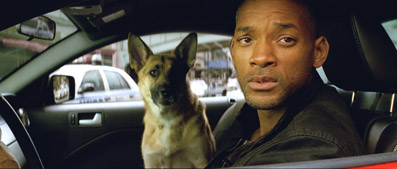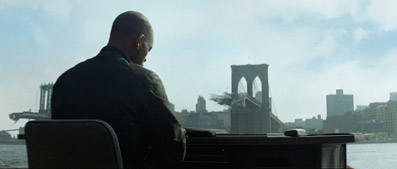"A man could get used to anything if he had to." |
Chapter One of Richard Matheson's I Am Legend |
But I still can't get used to CG people and animals in a movie featuring real people and real animals. So on the heels of my bemoaning the CG saturated Hollywood template in my review of the year, comes a movie that so neatly divides CG's pros and cons, it almost seems made to measure, a bear trap for almost immediate comment. The first moments of Francis (Constantine) Lawrence's interpretation of a New York ravaged by neglect is, on the big screen, simply jaw dropping. The mundane truth of a deserted Manhattan belies what must have been months of meticulous CG work, both modelling and compositing. Even if the city cooperated to the nth degree, you would not get this level of lifelessness, of glorious abandon. The dingy greenery poking through the sidewalks and road cracks are a small detail but the whole environment is sold within a few static wide shots. The aerial overhead of deserted streets (that angle popularised by Ridley Scott's literal sounding title, Someone To Watch Over Me) shows a nifty red sports car zooming through the city – a hunter looking for prey. This is Will Smith, the only (civilised) man left alive who's looking for answers...

I Am Legend is based on a Richard Matheson novella much quoted and borrowed from since its publication in 1954. There have been other film adaptations but none so grand as befits Hollywood's succumbing to an almost complete cinematic invasion of the digital. This is Matheson's intimate story writ studio blockbuster. It's an odd choice for a star vehicle although playing the last man on earth must appeal to some actors with an unfeasibly large superiority complex. Will Smith (who gives, I must say, an excellent performance of a man on the brink of suicidal depression) is Robert Neville, a military scientist who opts to stay at 'ground zero' whilst his family and the entire inhabitants of New York are urgently relocated elsewhere. Why? Well, Dr. Emma Thompson (one minute in a frock in the 19th century, the next, wiping out the human race, an actor's life for me) decided to genetically mutate disease genes and cure cancer! Hurrah! Except there was a price to pay – everyone 'cured' turned into superhuman zombies and the terrible virus became airborne (tchah, what's a gene here and there?). Everyone is either gone or has succumbed to the disease except Smith who tries out all sorts of antibodies on captured infected rodents in his cellar.
In the novel, the creatures are human vampires at the mercy of the old vampire lore (garlic, light etc. clichéd deterrents given a measure of scientific respectability). In the movie, they are the 'infected', super-fast and as agile as a simian on LSD – Danny Boyle's 28 Days Later's zombies in short or in long. The logic in the movie is that the price these human creatures pay for their super-human abilities is an intense aversion to sunlight. Fair enough; vampires by any other name would smell as sweet (once flesh-roasted in daylight). Oh, and they can also alter their own physiology – mouths open too wide, Mummy-style. But compared to the absolute photo-realism of a deserted New York City, these creatures are so obviously CG, so stridently 'not there' in the frame that despite any protestations of realism, the creatures derail the movie the first time they are glimpsed. Yes, the sound effects and the big open-mouthed screams can be a bit jarring but again, we're in Shrek-world. What? I hear you cry. What about what you said about Beowulf? Yes, but Beowulf existed in a 100% digital milieu so 'realism' looked starkly less out of place despite the unreality of the mise en scene.
Smith holds his own, trying to maintain a life stifled by open spaces and the longeurs of days and weeks without fellow human contact. After a brutal attack, he sets up a trap and snares an infected woman on whom he experiments. There is a ray of hope that Smith may actually be making progress but he misinterprets the signs. At the capture, the lead zombie, a stern looking CG humanoid, stands in the sunlit doorway for quite some time as his skin smokes and crisps. His scraps of humanity are dismissed by Neville in a video diary. What the scientist sees as a total social de-evolution, acting against the survival instinct, can be seen as compassion for someone Neville has caught, someone who means something to this bullet headed 'infected'. It's a theme that was to have resonance at the ending but for some reason the film-makers or execs chickened out (or they found their first ending didn't work with audiences). More on that later.

When Neville is trapped in an almost identical fashion (by de-evolved human creatures – who can set traps?) his path is set and in a unique suicide attempt, after a devastating loss, he is rescued to face the last attack with the fate of the world resting on his shoulders... Once again, Hollywood turns down the easy road and stuffs the intellectual content of Matheson's book into a dark "For People Who Care" folder which, ironically, will never see the light of day and this is a great pity. The book's central idea (and the explanation for the curious title) is that if society breaks down, a new 'norm' is established and anyone acting against that norm (by killing vampires during the day for example) is seen as aberrant. As the literary Neville succumbs to his new world order, he understands why he has to be executed (as all monsters must be), he muses on his own terrifying nature, the creature of the day who kills indiscriminately. It's a wonderful subversion but not acknowledged in the new film at all.
In the latest and rather excellent special effects magazine Cinefex – which must have a lead time of six months or so – there is an article on I Am Legend and due to the nature of the magazine coverage they tell the entire story noting how effects were achieved along the way. The ending they describe is certainly not the one on offer at the cinemas... So one must assume the original ending acknowledged the lead infected creature's desire to have his woman back (apparently the motion capture of this performance was painstaking) and he lets Neville and his surviving friends escape. We are at least left with the sense that a new sub or in-human order is being established, a nod at the very least to the DNA of the novella. You'd have thought a 'happy' ending would be right up Hollywood's street. Not to give away what's in the cinema, but it's a damn sight less ambitious. All I can think is that preview audiences couldn't easily understand that Mr. lead Zombie wanted Mrs. Zombie back. I'll get the DVD just to find out why that original ending didn't play.
You see, the only point of retaining the original title (the last phrase of the novella) would be to present Matheson's ideas intact – but no! This is Hollywood. Because Neville has found a cure (ho hum) he will become a (drum roll...) legend. Oh please. Alexander Fleming is not a legend for discovering penicillin! All in all, a bit of a wasted opportunity for intelligent science fiction and despite its grosses, a film with the potential of a Roman candle sputtering Catherine wheel-like at the whims of a preview audience and executive cowardice. Yes, a good enough line to end on but I have no proof of any of these conjectures except that article in Cinefex. Maybe the executives put up a brave front for an intellectual, brave, compelling and ambiguous ending. I'm smiling, wide eyed at those words actually appearing in the same sentence.
Last word. Is Will Smith the destroyer of intelligent science fiction? I gave I, Robot a fairly good review (for what it was) but it wasn't Asimov. Neither is Legend, Matheson. What's next? Please don't tell me he's developing a script for More Than Human? Please?
|